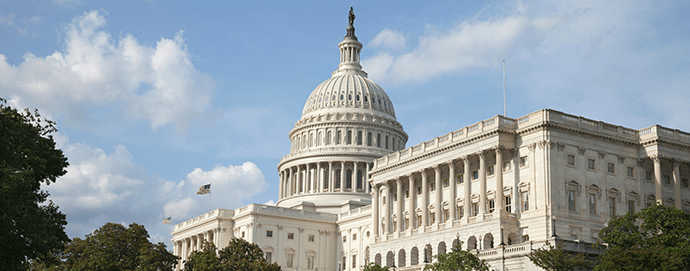Tax Cuts and Jobs Act of 2017
Provisions and Implications of the Tax Act on the Muni Market

On December 22, 2017, President Trump signed into law the Tax Cuts and Jobs Act of 2017. Key provisions of the new law and the potential implications they may have on municipal bond issuance are highlighted below. This list is not all-inclusive; issuers should consult with bond/tax counsel for a greater understanding of the potential effects of the Act.
ADVANCE REFUNDINGS ELIMINATED
The Act eliminates the ability of governmental issuers and issuers of qualified 501(c)(3) bonds to benefit from issuing advance refunding bonds (i.e., bonds issued more than 90 days before the redemption of the refunded bonds) on a tax-exempt basis. This provision in the Act became effective on January 1, 2018. It did not allow for grandfathering regarding outstanding bonds or any delay in implementation, nor did it include transition rules that would allow issuers time to adjust to the new provisions. As a result, issuers are now unable to issue advance-refunding bonds on a tax-exempt basis, and the cost for issuers and borrowers to lock-in debt service savings, restructure debt service, or to achieve relief from unfavorable financing terms is significantly increased. As summarized below, a number of alternatives are available to address the elimination of tax-exempt advance refundings, but so far it appears that all such options are more costly and often more complex.
TOOLS TO MITIGATE TAX REFORM
Forward Delivery Bonds: Cost is driven by the shape of the yield curve, but only has limited applications.
Shorter Calls: Not a demand issue as investors will buy at certain levels, but this option will be costly.
Taxable Bonds: Can be used to advance refund tax-exempt bonds, although more costly.
Alternative Structures: VRDNs, FRN’s, Put Bonds, etc. can be used to reduce cost or provide flexibility, but have inherent risks.
Synthetic Structures: Can be used to manage variable rate debt and provide additional flexibilities, but come with costs and risks.
TAX CREDIT BONDS ELIMINATED
The Act eliminates future issuances of “qualified tax credit bonds,” which include Build America Bonds, Qualified School Construction Bonds, Qualified Zone Academy Bonds, Clean Renewable Energy Bonds, Qualified Energy Conservation Bonds, and others. Although interest on tax credit bonds is not tax-exempt, these types of bonds have nevertheless allowed municipal issuers to achieve a lower cost of capital on certain infrastructure projects by entitling the holder to a federal tax credit or, in certain cases, the issuer to receive a subsidy payment directly from the federal government. While no new tax credit bonds can be issued after December 31, 2017, it is expected that holders and issuers of tax credit bonds issued before 2018 will continue to be eligible to receive the federal tax credit or federal subsidy payment, as applicable (although direct federal subsidy payments may be subject to future sequestration).
PRIVATE ACTIVITY BONDS SAVED, FOR NOW
The Senate did not include the House’s final version of the bill that eliminated the issuance of PABs. The final Act signed by the President retains all categories of tax-exempt PABs, which include bonds issued for projects owned by 501(c)(3) organizations; low-income multifamily housing developments; single-family mortgage bonds; airports; docks, wharves and ports; sewage and solid waste facilities; mass commuting facilities; and facilities for the furnishing of water. This is also particularly good news for projects reliant on the coordination of multiple sources of financing, such as affordable housing developments and public-private partnerships.
EFFECT OF TAX RATE CHANGES ON ISSUERS
The Act changed the income tax calculation for U.S. taxpayers, including changes to deductions, credits and marginal tax rates. This includes the replacement of graduated corporate tax rates ranging from 15% to 35% with a flat corporate rate of 21% and the repeal of the 20% corporate alternative minimum tax (AMT). Excluding all other factors, a reduction in income tax rates will reduce demand for tax-exempt bonds and/or increase tax-exempt yields required by corporate investors, such as banks and other financial institutions. Because the changes in tax law may not affect all investor classes equally and may be different depending on the state in which the investor is located, the effect of these changes on demand for tax-exempt bonds and required investor yields is still being determined.
OTHER ITEMS OF INTEREST
Both New Market Tax Credits and stadium financings with tax-exempt debt are, however, unaffected and thus still allowed. Also of potential interest, “qualified tax credit bonds” (i.e., Build America Bonds, Qualified School Construction Bonds, Qualified Zone Academy Bonds, Clean Renewable Energy Bonds, Qualified Energy Conservation Bonds, and others) for which the issuer elected to receive a direct credit subsidy will continue to be subject to sequestration. This means that refund payments/offset transactions processed on or after October 1, 2017, and on or before September 30, 2018, will be reduced by federal fiscal year 2018’s sequestration rate of 6.6%. The sequestration reduction rate will be applied unless and until a law is enacted that cancels or otherwise affects the Sequester, at which time the sequestration reduction rate is subject to change.
BOTTOM LINE
Most municipal issuers may likely see increased costs in managing their debt capital structure and will need to work with their finance teams to customize solutions that meet their financial goals, risk tolerances, etc. Please contact your nearest Raymond James Public Finance office with any questions you may have or to discuss this information further.